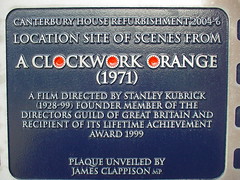Stanley Kubrick
Stanley Kubrick
(1928-1999)
Commemorated on 2 plaques
Canterbury House Refurbishment 2004-6 Location site of scenes from A Clockwork Orange (1971) a film directed by Stanley Kubrick (1928-99) founder member of the Directors Guild of Great Britain and recipient of its lifetime achievement award 1999
Canterbury House, Stratfield Road, Borehamwood, United Kingdom where they directed
Centenary Of Cinema 1996 #098
Stanley Kubrick worked on Lolita, 2001 and The Shining here [full inscription unknown]
Elstree Film Studios, Borehamwood, United Kingdom where they filmed


